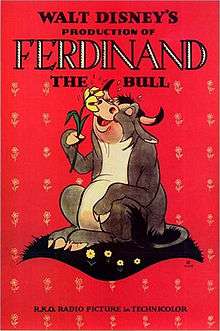Ferdinand the Bull (film)
| Ferdinand the Bull | |
|---|---|
 Theatrical release poster | |
| Directed by | Dick Rickard |
| Produced by | Walt Disney |
| Narrated by | Don Wilson |
| Studio | Walt Disney Productions |
| Distributed by | RKO Radio Pictures |
| Running time | 7 minutes, 14 seconds |
| Country | United States |
| Language | English |
Ferdinand the Bull is a 1938 American stand-alone animated short produced by Walt Disney Productions and released on November 25, 1938 by RKO Radio Pictures. It was directed by Dick Rickard and based on the book, The Story of Ferdinand by Munro Leaf.
Plot
In the beginning, there are a lot of bulls, romping around together and butting their heads. There was only one bull who wasn't doing that, and that was Ferdinand. All he wanted to do was go under a shady cork tree and smell the flowers all day. Then one day his mother noticed that he wasn't playing with the other bulls. His mom asked him why he wasn't butting his head with the other bulls. He replied that all he wanted to do was to sit and smell the flowers. Luckily, his mother was very understanding.
Over the years, Ferdinand grew and grew until he was as big as the tree. The other bulls wanted to accomplish one goal in life: to be in the bullfights in Madrid, Spain, but not Ferdinand. Then one day, five strange-looking men were here to see the bulls. When the bulls noticed them, they fought as rough as possible, hoping that they would get picked, but not Ferdinand who went back to smell the flowers. Just as Ferdinand was sitting, he accidentally sat on a bumblebee. That made him go crazy and on a rampage, knocking the other bulls out and crashed into a tree, making it fall down. The five men cheered as they took Ferdinand to Madrid.
There was a lot of excitement when the day of the bullfight came. On posters, they called him Ferdinand the Fierce. At the ring came out banderilleros, picadors and the matador who was being cheered on. When he was bowing, a woman in the audience gave him a bouquet of flowers which landed in his hand. Then the moment came where Ferdinand came out. He was wondering what was he doing there. The banderilleros and picadors were scared and hid, but the matador was scared stiff because Ferdinand was so big and strong. But Ferdinand looked up in the stands and saw all of the beautiful hats that the women were wearing, each decorated with lovely, fragrant flowers. He couldn't stop staring at all the beautiful hats. The matador was very angry that Ferdinand wasn't charging at him. But Ferdinand was not interested in fighting; he was only interested in admiring the beautiful flowers. Eventually, he was led out of the arena smelling the flowers and taken back home where he continued to sit under the tree and smell the flowers.
Sequels
There was a book sequel to this cartoon called "Ferdinand and the Bullies", a part of the Walt Disney's Fun-to-Read Library.
Reception
The short film is broadcast in several countries every year on Christmas Eve as a part of the annual Disney Christmas show From All of Us to All of You. The Christmas show is especially popular in Sweden where it has aired since 1959 and has become a Christmas tradition. The replacement of Ferdinand the Bull with The Ugly Duckling in 1982 resulted in public outcry. The next year, in 1983, the change was reverted and Ferdinand the Bull returned to Swedish television.[1]
Awards
Ferdinand the Bull won the 1938 Academy Award for Best Short Subject (Cartoons). It won against shorts such as Mother Goose Goes Hollywood.
Home Video Release
- Walt Disney Mini-Classics: Willie the Operatic Whale (VHS) 1991
- Disney Rarities: Celebrated Shorts: 1920s-1960s (DVD) 2005
- Walt Disney's Timeless Tales Volume 2: The Ugly Duckling/Wind in the Willows/The Country Cousin (DVD) 2005
- Walt Disney Animation Collection: Classic Short Films Volume 6: The Reluctant Dragon (DVD) 2009
Notes
1. ^ Walt Disney's Timeless Tales Volume 2 at the of Los Angeles Public Library Catalog
References
- ↑ Stahl, Jeremy (22 December 2011). "Nordic Quack – Sweden's bizarre tradition of watching Donald Duck cartoons on Christmas Eve". Slate.
External links
- Ferdinand the Bull at the Internet Movie Database
- Ferdinand the Bull at The Big Cartoon DataBase
- Ferdinand the Bull, in the Encyclopedia of Disney Animated Shorts